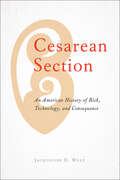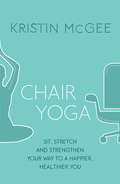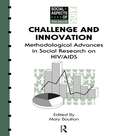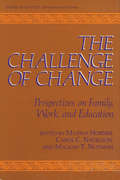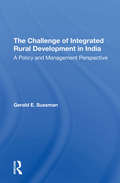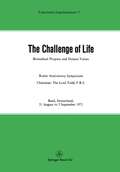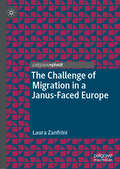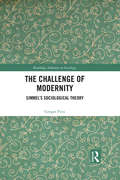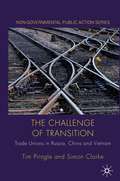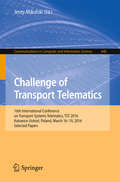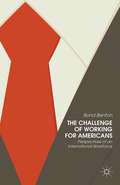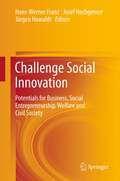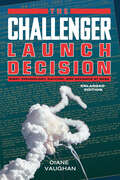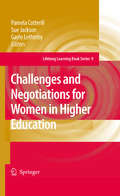- Table View
- List View
Cesar Chavez and the United Farm Workers Movement (Landmarks of the American Mosaic)
by Roger BrunsThis book offers an illuminating story of how social and political change can sometimes result from the vision, leadership, and commitment of a few dedicated individuals determined not to fail.Cesar Chavez and the United Farm Workers Movement chronicles the drive for a union of one of American society's most exploited groups. It is a story of courage and determination, set against the backdrop of the 1960s, a time of assassinations, war protests, civil rights battles, and reform efforts for poor and minority citizens.American farm workers were men and women on labor's last rung, living in desperate and inhumane conditions, poisoned by pesticides, and making a pittance for back-breaking work. The book shows how these migrant workers found a champion in Chavez and the United Farm Workers Union. With the help of quotes from documentary material only recently made available, it tells the story of the boycotts, marches, and strikes—including hunger strikes—used to force concessions for better conditions and pay. It also shows how the farm workers movement helped set the stage for growing Latino cultural awareness and political power.
Cesarean Section: An American History of Risk, Technology, and Consequence
by Jacqueline H. WolfBetween 1965 and 1987, the cesarean section rate in the United States rose precipitously;¢;‚¬;€?from 4.5 percent to 25 percent of births. By 2009, one in three births was by cesarean, a far higher number than the 5;€“10% rate that the World Health Organization suggests is optimal. While physicians largely avoided cesareans through the mid-twentieth century, by the early twenty-first century, cesarean section was the most commonly performed surgery in the country. Although the procedure can be life-saving, how;¢;‚¬;€?and why;¢;‚¬;€?did it become so ubiquitous?Cesarean Section is the first book to chronicle this history. In exploring the creation of the complex social, cultural, economic, and medical factors leading to the surgery;€™s increase, Jacqueline H. Wolf describes obstetricians;€™ reliance on assorted medical technologies that weakened the skills they had traditionally employed to foster vaginal birth. She also reflects on an unsettling malpractice climate;¢;‚¬;€?prompted in part by a raft of dubious diagnoses;¢;‚¬;€?that helped to legitimize "defensive medicine," and a health care system that ensured cesarean birth would be more lucrative than vaginal birth. In exaggerating the risks of vaginal birth, doctors and patients alike came to view cesareans as normal and, increasingly, as essential. Sweeping change in women;€™s lives beginning in the 1970s cemented this markedly different approach to childbirth. Wolf examines the public health effects of a high cesarean rate and explains how the language of reproductive choice has been used to discourage debate about cesareans and the risks associated with the surgery. Drawing on data from nineteenth- and early twentieth-century obstetric logs to better represent the experience of cesarean surgery for women of all classes and races, as well as interviews with obstetricians who have performed cesareans and women who have given birth by cesarean, Cesarean Section is the definitive history of the use of this surgical procedure and its effects on women;€™s and children;€™s health in the United States.
Cesarean Section: An American History of Risk, Technology, and Consequence
by Jacqueline H. WolfBetween 1965 and 1987, the cesarean section rate in the United States rose precipitously;¢;‚¬;€?from 4.5 percent to 25 percent of births. By 2009, one in three births was by cesarean, a far higher number than the 5;€“10% rate that the World Health Organization suggests is optimal. While physicians largely avoided cesareans through the mid-twentieth century, by the early twenty-first century, cesarean section was the most commonly performed surgery in the country. Although the procedure can be life-saving, how;¢;‚¬;€?and why;¢;‚¬;€?did it become so ubiquitous?Cesarean Section is the first book to chronicle this history. In exploring the creation of the complex social, cultural, economic, and medical factors leading to the surgery;€™s increase, Jacqueline H. Wolf describes obstetricians;€™ reliance on assorted medical technologies that weakened the skills they had traditionally employed to foster vaginal birth. She also reflects on an unsettling malpractice climate;¢;‚¬;€?prompted in part by a raft of dubious diagnoses;¢;‚¬;€?that helped to legitimize "defensive medicine," and a health care system that ensured cesarean birth would be more lucrative than vaginal birth. In exaggerating the risks of vaginal birth, doctors and patients alike came to view cesareans as normal and, increasingly, as essential. Sweeping change in women;€™s lives beginning in the 1970s cemented this markedly different approach to childbirth. Wolf examines the public health effects of a high cesarean rate and explains how the language of reproductive choice has been used to discourage debate about cesareans and the risks associated with the surgery. Drawing on data from nineteenth- and early twentieth-century obstetric logs to better represent the experience of cesarean surgery for women of all classes and races, as well as interviews with obstetricians who have performed cesareans and women who have given birth by cesarean, Cesarean Section is the definitive history of the use of this surgical procedure and its effects on women;€™s and children;€™s health in the United States.
Chaim L. Pekeris and the Art of Applying Mathematics with WEIZAC, 1955–1963 (SpringerBriefs in History of Science and Technology)
by Leo Corry Raya LeviathanThis book describes the groundbreaking work of Chaim Leib Pekeris and his collaborators. Between 1955 and 1963 they used the first electronic computer built in Israel, the Weizmann Automatic Computer (WEIZAC), to develop powerful numerical methods that helped achieve new and accurate solutions of the Boltzmann equation, calculate energy levels of the helium atom, produce detailed geophysical and seismological models derived from the study of the free oscillations of the earth, and refine models used to predict meteorological phenomena and global oceanic tides. This book provides a unique account of the pioneering work of Chaim L. Pekeris in applied mathematics and explains in detail the background to the rise of the Weizmann Institute as a world-class center of scientific excellence. This hitherto untold story is of great interest to historians of twentieth-century science with special emphasis on the application of computer-assisted numerical methods in various branches of mathematical physics.
Chair Yoga: Sit, Stretch, and Strengthen Your Way to a Happier, Healthier You
by Kristin McGeeEveryone knows that sitting down for long periods of time increases the risk of disability, diabetes and heart disease. Now you can do something about it with the help of Chair Yoga!With over 100 seated yoga poses Chair Yoga is the perfect handbook for office workers and older people who want to practice yoga. These simple exercises will help to strengthen and stretch your body whilst relaxing your mind and regulating your breathing.Divided into chapters organised by body part, celebrity yoga instructor Kristin McGee will guide you through each pose with step-by-step instructions and easy-to-follow photosFeel the mental and physical effects of chair yoga every day and embrace the calmer, healthier, happier you.
The Challenge for Energy Justice: Correcting Human Rights Abuses
by Raphael J HeffronWritten by one of the world’s leading scholars in the field, this book provides a unique perspective on the connections between energy justice and human rights. Taking an interdisciplinary approach, the author offers an accessible discussion about the implementation of energy justice in practice. The book explores the rise of justice issues in the energy sector, the interdisciplinary nature of energy justice, the economics of energy justice and provides a practical case study on distributive justice. The penultimate chapter focuses on human rights and energy justice in a world first, and explores the topic from the perspective of the opportunity of last resort. This ‘opportunity of last resort’ is the national courts and is the place where societies can seek to have justice enforced through a variety of human rights being protected. Finally, energy justice risks are highlighted alongside the author’s proposed framework for the next generation of energy justice scholars.
Challenge & Innovation: Methodological Advances In Social Research On Hiv/aids (Social Aspects Of Aids Ser.)
by Mary BoultonFirst published in 1994. Routledge is an imprint of Taylor & Francis, an informa company.
Challenge & Innovation
by Mary BoultonFirst published in 1994. Routledge is an imprint of Taylor & Francis, an informa company.
The Challenge of Change: Perspectives on Family, Work, and Education (Women in Context)
by Matina Horner, Carol C. Nadelson and Malkah T. NotmanThis book is a compilation and update of a group of provocative papers presented at the Radcliffe College invitational conference, "Perspectives on the Patterns of an Era: Family, Work, and Education." A scholarly event saluting Radcliffe's centenary, the conference examined a range of indicators of social change, particularly as they relate to women in America in the last two decades. The program was interdisciplinary, bringing together scholars from economics, history, psychology, sociol ogy, and psychiatry. Each conference participant was asked to explore, theoretically and empirically, the lessons of our social history and, as much as possible, to separate myth from reality with regard to recent changes in patterns of family life, work, and education. Particular emphasis was given to the examination of the rapid changes-or what have been assumed to be the rapid changes-of the last two decades. In addition, participants ana lyzed the perceived and actual costs and benefits associated with chang ing lifestyles, for women and men as individuals and for society as a whole. Finally, they considered the implications of their findings for the future and identified areas for further research.
The Challenge of East-West Migration for Poland (Studies in Russia and East Europe)
by Keith Sword Krystyna IglickaOne of the major features of the social landscape of the new states of Eastern Europe and the former USSR is migration, whether voluntary or coerced. The decline of communism in both East and Central Europe, as well as the fall of the Soviet empire has created new population and ethnic problems. The recent exodus has proved to be the largest migration wave reported in Europe in over 40 years. The problem of foreigners in Poland is a subject scarcely studied and insufficiently described. This volume has been compiled on the basis of papers prepared for a Social Sciences Seminar series at the School of Slavonic Studies, London, which was devoted to migratory movements in Poland since 1989. This volume thus contains the latest data and results of research (quantitative as well as qualitative) on the movement of foreigners into Poland. It is a groundbreaking work.
The Challenge Of Integrated Rural Development In India: A Policy And Management Perspective
by Gerald E SussmanIn 1952, India launched a massive and enthusiastic effort to reach the 360 million people in its 550,000 villages with a national program of economic and social reconstruction. Known as Community Development, the program provided an innovative model of rural development for both Third World nations and the aid-giving countries of the West. Although the program achieved its goal of providing service coverage to the nation, its many implementation problems and the lack of quantifiable cost-effectiveness led critics to label it a failure and resulted in its submergence into the Ministry of Food and Agriculture in 1966. More recently, however, partly as a result of the social dislocations following the "Green Revolution," there has been renewed interest in Community Development as the Indian government searches for ways of effectively implementing a strategy of integrated rural development. It is recognized that a repeat of the CD program is not the answer; but an analysis of the program allows the identification of the elements critical to good administration—and political survival. Drawing on extensive interviews with Indian and American participants, this book critically appraises the Community Development program. Dr. Sussman examines the successful pilot project at Etawah, then documents the many problems—organizational, political, and logistical—that were encountered in the attempt to replicate it on a nationwide scale, and that eventually led to its demise. From his analysis emerges the question of what kind of government strategies can best equip rural populations to participate in development. Admitting the difficulties still to be faced, he concludes on a note of guarded optimism based on recent efforts in both India and the U.S. that combine a systems approach with the use of a range of development strategies.
The Challenge Of Integrated Rural Development In India: A Policy And Management Perspective
by Gerald E SussmanIn 1952, India launched a massive and enthusiastic effort to reach the 360 million people in its 550,000 villages with a national program of economic and social reconstruction. Known as Community Development, the program provided an innovative model of rural development for both Third World nations and the aid-giving countries of the West. Although the program achieved its goal of providing service coverage to the nation, its many implementation problems and the lack of quantifiable cost-effectiveness led critics to label it a failure and resulted in its submergence into the Ministry of Food and Agriculture in 1966. More recently, however, partly as a result of the social dislocations following the "Green Revolution," there has been renewed interest in Community Development as the Indian government searches for ways of effectively implementing a strategy of integrated rural development. It is recognized that a repeat of the CD program is not the answer; but an analysis of the program allows the identification of the elements critical to good administration—and political survival. Drawing on extensive interviews with Indian and American participants, this book critically appraises the Community Development program. Dr. Sussman examines the successful pilot project at Etawah, then documents the many problems—organizational, political, and logistical—that were encountered in the attempt to replicate it on a nationwide scale, and that eventually led to its demise. From his analysis emerges the question of what kind of government strategies can best equip rural populations to participate in development. Admitting the difficulties still to be faced, he concludes on a note of guarded optimism based on recent efforts in both India and the U.S. that combine a systems approach with the use of a range of development strategies.
The Challenge of Life: Biomedical Progress and Human Values (Experientia Supplementum #17)
by Kunz FehrIn the autumn of 1971 F. Hoffmann-La Roche & Co. Ltd in Basel celebrated their 75th anniversary. The company was one of the first in the chemical industry to concentrate from the beginning on pharmaceuticals. Step by step new activi ties were taken up, but all within the frontiers of biology. During the 75 years of Roche the research division has become by far the largest department in the company, with basic research assuming an increasingly important part in it. For this reason Roche cannot but feel a share of res pons i bility towards the many problems raised by biomedical progress. Hence, the idea of celebrating the anniversary along conventional lines could not be seriously entertained. The occasion was to show Roche at work. A special kind of work certainly, breaking away from the daily routine into the sphere offree communi cation with thinking people outside the purview of the company's usual tasks.
The Challenge of Migration in a Janus-Faced Europe
by Laura ZanfriniThis book critically investigates the origins and consequences of the Janus-faced character of attitudes and policies towards migrants that seek to penetrate “Fortress Europe”. Beginning with an examination of its founding ambitions, it locates the roots of an ingrained ambivalence in the legacies of the post-war period and the unresolved tension between the economicism of the European approach to labour migration and the philosophy of rights and solidarity embedded in the EU project. It highlights how the formalization of citizenship rights has produced both formal pathways towards inclusion for migrants and, in their selective eligibility criteria, exclusive systems of civic stratification. The author links this oscillation between positions of closure and openness to the paradoxical trade-offs in migration policies, in particular labour market integration, demonstrated through unequal labour market outcomes, lower social mobility and educational attainments. The issues faced by migrants’ offspring in Europe are examined as paradigmatic of the struggle to balance competing calls for both pluralism and uniformity: to create a diverse society that can also project a homogenous collective identity. This balanced overview will provide an invaluable resource for students of migration studies, European politics, public policy, international relations and the sociology of racism.
The Challenge of Modernity: Simmel’s Sociological Theory (Routledge Advances in Sociology)
by Gregor FitziThe complete collected works of Georg Simmel are now available. Yet, the standing of Simmel’s sociological theory is still a subject of controversy. Is Simmel only a brilliant impressionist, a flâneur in the territories of modernity? Providing an illuminating and coherent presentation of Simmel’s sociological theory, The Challenge of Modernity seeks to demonstrate how Simmel contributed a structured sociological theory that fits the criteria of a ‘sociological grand theory’. Indeed, starting by the theory of modernity and its dimensions of social differentiation, monetarisation, culture reification and urbanisation; it reconstructs the architecture of Simmel’s sociological epistemology. Particular attention is dedicated to the theory of ‘qualitative societal differentiation’ that Simmel develops within his cultural sociology, with the late work being presented as a double contribution to the foundation of sociological anthropology and to the social ethics of complex societies. Presenting the entirety of Simmel’s manifold oeuvre from the viewpoint of its relevance for sociology, this comprehensive volume will appeal to scholars and advanced students who wish to understand Simmel’s relevance for socio-political thought and become acquainted with his contribution to sociological theory. It will also be of interest to the wider public who seek a critical assessment of our age in theoretical terms.
The Challenge of Modernity: Simmel’s Sociological Theory (Routledge Advances in Sociology)
by Gregor FitziThe complete collected works of Georg Simmel are now available. Yet, the standing of Simmel’s sociological theory is still a subject of controversy. Is Simmel only a brilliant impressionist, a flâneur in the territories of modernity? Providing an illuminating and coherent presentation of Simmel’s sociological theory, The Challenge of Modernity seeks to demonstrate how Simmel contributed a structured sociological theory that fits the criteria of a ‘sociological grand theory’. Indeed, starting by the theory of modernity and its dimensions of social differentiation, monetarisation, culture reification and urbanisation; it reconstructs the architecture of Simmel’s sociological epistemology. Particular attention is dedicated to the theory of ‘qualitative societal differentiation’ that Simmel develops within his cultural sociology, with the late work being presented as a double contribution to the foundation of sociological anthropology and to the social ethics of complex societies. Presenting the entirety of Simmel’s manifold oeuvre from the viewpoint of its relevance for sociology, this comprehensive volume will appeal to scholars and advanced students who wish to understand Simmel’s relevance for socio-political thought and become acquainted with his contribution to sociological theory. It will also be of interest to the wider public who seek a critical assessment of our age in theoretical terms.
The Challenge of Transition: Trade Unions in Russia, China and Vietnam (Non-Governmental Public Action)
by Tim Pringle Simon ClarkeThis book explores the transformation of employment relations, the rise of worker protest and the reform of trade union practice to ask how successfully the state-socialist trade unions have adapted to their new role of representing the rights and interests of workers.
Challenge of Transport Telematics: 16th International Conference on Transport Systems Telematics, TST 2016, Katowice-Ustroń, Poland, March 16–19, 2016, Selected Papers (Communications in Computer and Information Science #640)
by Jerzy MikulskiThis book constitutes the thoroughly refereed proceedings of the 16th International Conference on Transport Systems Telematics, TST 2016, held in Katowice-Ustrón, Poland, in March 2016. The 37 full and 5 short papers presented in this volume were carefully reviewed and selected from 110 submissions. They present and organize the knowledge from within the field of intelligent transportation systems, the specific solutions applied in it and their influence on improving efficiency of transport systems.
The Challenge of Working for Americans: Perspectives of an International Workforce
by Bond BentonThe global focus of corporations, government institutions, and NGOs have led to a defining question of the era: How do foreigners feel about working for Americans? Through surveys with over 700 Foreign Service nationals working within the US State Department, Benton examines perceptions of non-Americans working in overtly American environments.
Challenge Social Innovation: Potentials for Business, Social Entrepreneurship, Welfare and Civil Society
by Hans-Werner Franz, Josef Hochgerner and Jürgen HowaldtIn recent years, social innovation has experienced a steep career. Numerous national governments and large organisations like the OECD, the European Commission and UNESCO have adopted the term. Social innovation basically means that people adopt new social practices in order to meet social needs in a different or more effective way. Prominent examples of the past are the Red Cross and the social welfare state or, at present, the internet 2.0 transforming our communication and cooperation schemes, requiring new management concepts, even empowering social revolutions. The traditional concept of innovation as successful new technological products needs fundamental rethinking in a society marked by knowledge and services, leading to a new and enriched paradigm of innovation. There is multiple evidence that social innovation will become of growing importance not only concerning social integration, equal opportunities and dealing with the greenhouse effects but also with regard to preserving and expanding the innovative capacity of companies and societies. While political authorities stress the social facets of social innovation, this book also encompasses its societal and systemic dimensions, collecting the scientific expertise of renowned experts and scholars from all over the world. Based on the contributions of the first world-wide science convention on social innovation from September 2011 in Vienna, the book provides an overview of scientific approaches to this still relatively new field.Forewords by Agnès HUBERT (Member of the Bureau of European Policy Advisers (BEPA) of the European Commission) and Antonella Noya (Senior Policy Analyst at OECD, manager of the OECD LEED Forum on Social Innovations)
The Challenger Launch Decision: Risky Technology, Culture, and Deviance at NASA, Enlarged Edition
by Diane VaughanWhen the Space Shuttle Challenger exploded on January 28, 1986, millions of Americans became bound together in a single, historic moment. Many still vividly remember exactly where they were and what they were doing when they heard about the tragedy. Diane Vaughan recreates the steps leading up to that fateful decision, contradicting conventional interpretations to prove that what occurred at NASA was not skullduggery or misconduct but a disastrous mistake. Why did NASA managers, who not only had all the information prior to the launch but also were warned against it, decide to proceed? In retelling how the decision unfolded through the eyes of the managers and the engineers, Vaughan uncovers an incremental descent into poor judgment, supported by a culture of high-risk technology. She reveals how and why NASA insiders, when repeatedly faced with evidence that something was wrong, normalized the deviance so that it became acceptable to them. In a new preface, Vaughan reveals the ramifications for this book and for her when a similar decision-making process brought down NASA's Space Shuttle Columbia in 2003.
The Challenger Launch Decision: Risky Technology, Culture, and Deviance at NASA, Enlarged Edition
by Diane VaughanWhen the Space Shuttle Challenger exploded on January 28, 1986, millions of Americans became bound together in a single, historic moment. Many still vividly remember exactly where they were and what they were doing when they heard about the tragedy. Diane Vaughan recreates the steps leading up to that fateful decision, contradicting conventional interpretations to prove that what occurred at NASA was not skullduggery or misconduct but a disastrous mistake. Why did NASA managers, who not only had all the information prior to the launch but also were warned against it, decide to proceed? In retelling how the decision unfolded through the eyes of the managers and the engineers, Vaughan uncovers an incremental descent into poor judgment, supported by a culture of high-risk technology. She reveals how and why NASA insiders, when repeatedly faced with evidence that something was wrong, normalized the deviance so that it became acceptable to them. In a new preface, Vaughan reveals the ramifications for this book and for her when a similar decision-making process brought down NASA's Space Shuttle Columbia in 2003.
The Challenger Launch Decision: Risky Technology, Culture, and Deviance at NASA, Enlarged Edition
by Diane VaughanWhen the Space Shuttle Challenger exploded on January 28, 1986, millions of Americans became bound together in a single, historic moment. Many still vividly remember exactly where they were and what they were doing when they heard about the tragedy. Diane Vaughan recreates the steps leading up to that fateful decision, contradicting conventional interpretations to prove that what occurred at NASA was not skullduggery or misconduct but a disastrous mistake. Why did NASA managers, who not only had all the information prior to the launch but also were warned against it, decide to proceed? In retelling how the decision unfolded through the eyes of the managers and the engineers, Vaughan uncovers an incremental descent into poor judgment, supported by a culture of high-risk technology. She reveals how and why NASA insiders, when repeatedly faced with evidence that something was wrong, normalized the deviance so that it became acceptable to them. In a new preface, Vaughan reveals the ramifications for this book and for her when a similar decision-making process brought down NASA's Space Shuttle Columbia in 2003.
The Challenger Launch Decision: Risky Technology, Culture, and Deviance at NASA, Enlarged Edition
by Diane VaughanWhen the Space Shuttle Challenger exploded on January 28, 1986, millions of Americans became bound together in a single, historic moment. Many still vividly remember exactly where they were and what they were doing when they heard about the tragedy. Diane Vaughan recreates the steps leading up to that fateful decision, contradicting conventional interpretations to prove that what occurred at NASA was not skullduggery or misconduct but a disastrous mistake. Why did NASA managers, who not only had all the information prior to the launch but also were warned against it, decide to proceed? In retelling how the decision unfolded through the eyes of the managers and the engineers, Vaughan uncovers an incremental descent into poor judgment, supported by a culture of high-risk technology. She reveals how and why NASA insiders, when repeatedly faced with evidence that something was wrong, normalized the deviance so that it became acceptable to them. In a new preface, Vaughan reveals the ramifications for this book and for her when a similar decision-making process brought down NASA's Space Shuttle Columbia in 2003.
Challenges and Negotiations for Women in Higher Education (Lifelong Learning Book Series #9)
by Pamela Cotterill Sue Jackson Gayle LetherbyThis book offers a clear, accessible exploration of lifelong learning and educational opportunities for women in higher education. It has been developed from work undertaken by members of the Women in Higher Education Network with chapters organized in three thematic sections: Ambivalent Positions in the Academy, Process and Pedagogy at Work, Career – Identity – Home.

